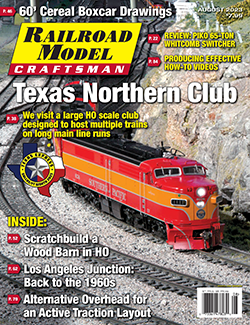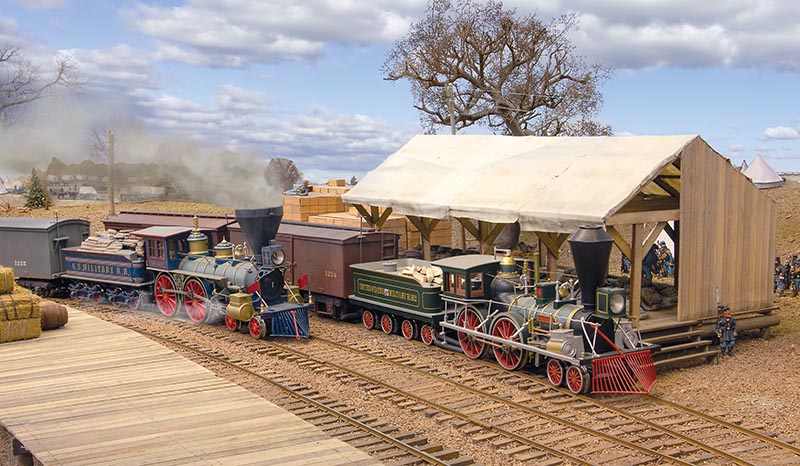 Ever since my dad purchased an ancient MPC General kit on eBay several years ago, I have been fascinated with the 4-4-0 locomotive. Something about that stately engine was so captivating to my 4-year-old eyes, whether it was the large cowcatcher, bright reds, shiny brass, or the thrill of The Great Locomotive Chase, which I watched repeatedly. I have loved these locomotives for as long as I can remember.
Ever since my dad purchased an ancient MPC General kit on eBay several years ago, I have been fascinated with the 4-4-0 locomotive. Something about that stately engine was so captivating to my 4-year-old eyes, whether it was the large cowcatcher, bright reds, shiny brass, or the thrill of The Great Locomotive Chase, which I watched repeatedly. I have loved these locomotives for as long as I can remember.
I remember begging for a Jupiter when I was getting into modeling. My overwhelming excitement quickly diminished, though, once I began to run it. Even as a 9-year-old, I knew an engine built two centuries ago shouldn’t run as fast as a Shinkansen. As I grew older, I began to understand why more people weren’t modeling that era. Personal recollections aside, the options are rather limited — a few old metal kits by Arbour, out-of-scale 4-4-0s by Rivarossi, the infamous Tyco General, and expensive brass models. This may have satisfied the niche in the 1970s and 1980s, but with the advent of DCC control in the new millennium and the admittedly less hands-on approach more modelers take, the lack of decent pre-1900s equipment was clear.
That was, until Bachmann completely retooled their 4-4-0 in 2016. Now we had an 1800s-era 4-4-0 without the motor in the tender and DCC capabilities! What more could one ask for? I picked up my first one in 2019 and was blown away by the smooth running and overall satisfactory dimensions and stature. But it could have been better. A quick Google search revealed the sudden wealth of 3D-printed parts available to modify the 4-4-0, some of which I purchased to create Blaxland No. 1, for my freelance model railroad. This rather groundbreaking model opened the door for a new generation of modelers to experience this type of locomotive. For the first time in decades, it seemed as if there was some hope for the era finding its footing amidst the repetitive transition and 1990s-era equipment that dominates every aspect of the hobby.
Aside from this offering from Bachmann, most manufacturers today seem to have little interest in producing small steam prototypes, let alone 1800s-era locomotives. It is truly disappointing as we finally have the technology to make these types of engines a reality, but the demand is seemingly not present. Companies would rather invest in a new Big Boy tooling that will get swallowed up in the sea of many others than deliver a generic Mogul or small Consolidation.
I think that’s a shame. In this day and age, space, time, and money are of utmost concern in the hobby. But modeling the 1800s can easily address some of those issues. Locomotives are smaller, allowing for tighter curves, and better use of space; trains hauled by these engines were never made up of more than but a few cars, meaning not a lot is required to be spent to make up a prototypical consist. And the equipment is not only bristling with glimmering brass and vibrant color, but a rich history as well.
As of writing this, I have completed one engine for my fictional Blaxland Railroad, made from the aforementioned Bachmann 4-4-0, and I intend to build more. I have used a plethora of brass, plastic, and 3D-printed detail parts to further enhance this wonderful model and make it unique. A combination of painting techniques (spray paint, airbrushing, brush-painting) were employed to achieve the exact look that I wanted. That very engine is undergoing a third rebuild, as I continue to refine my skills, utilizing far more accurate 3D-printed components and techniques to bring it even closer to looking like something that may have existed back in the late 1800s. That’s the magic of these engines. Anything can look plausible. You can choose to follow a strict prototype, complete with working link and pin couplers and authentic simulated controls; or let your imagination run wild, painting up locomotives in purples, greens, and bright yellow. The distinction between fiction and reality can be much more easily blurred compared to other eras without too many questions being asked.
Smaller motors, 3D-printing, and the generally far more accessible references make the production of locomotives like these much more feasible than they were 50 years ago. Anything imaginable can be created with near-factory levels of fidelity, if not better. While those of us who model this compact and colorful era may not have the product resources of other modelers, we certainly get the joy that comes with going down the road less traveled.
—Alex Strauss



